Limited Time Offer!
For Less Than the Cost of a Starbucks Coffee, Access All DevOpsSchool Videos on YouTube Unlimitedly.
Master DevOps, SRE, DevSecOps Skills!
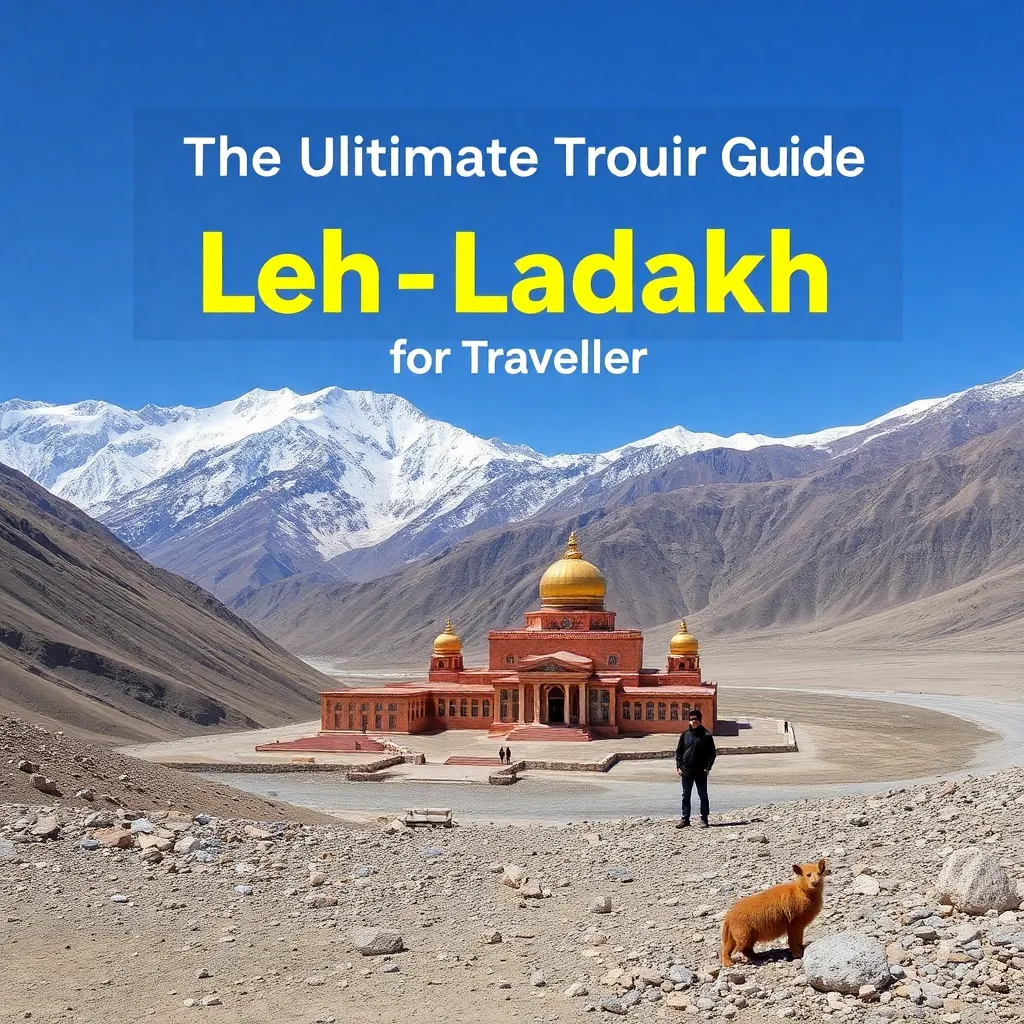
Introduction to Leh-Ladakh
Brief history and cultural significance.
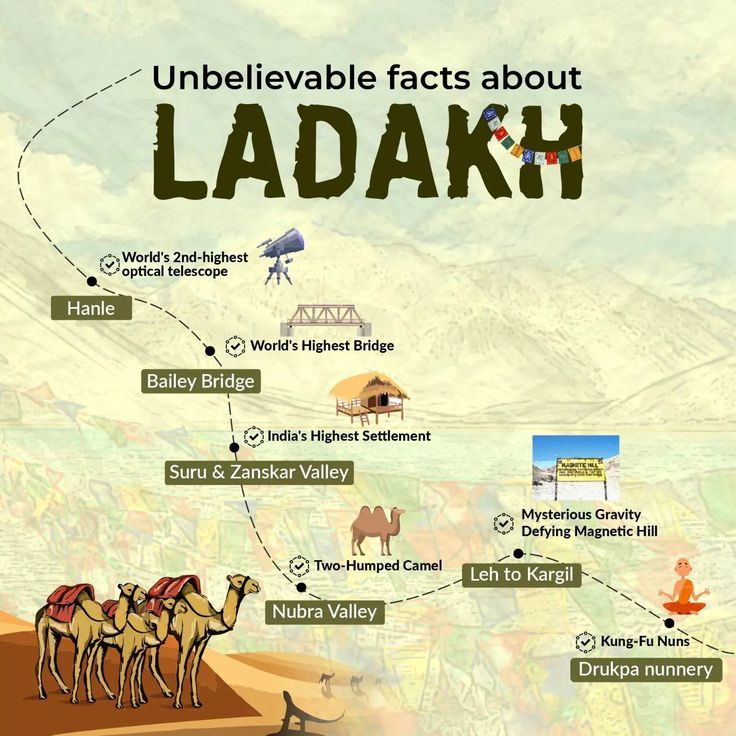
Leh-Ladakh, a region in the northern part of India, lies nestled amidst the Great Himalayas and the Karakoram ranges. Historically, it was an important trade route connecting the Indian subcontinent with the Silk Road, facilitating trade between China and the Middle East. This geographical and strategic importance has endowed Leh-Ladakh with a rich cultural tapestry influenced by Tibetan Buddhism, which is evident in its numerous monasteries, rituals, and festivals. The region was once a kingdom with its own royal family, which still holds a ceremonial role today.
Geographic overview and climate.
Geographically, Leh-Ladakh is characterized by stunning landscapes that include arid mountains, stark plateaus, and verdant valleys. It is bounded by two of the world’s highest mountain ranges: the Himalayas to the south and the Karakoram to the north. The Indus River flows through Ladakh, adding to the beauty and fertility of its valleys.
The climate of Leh-Ladakh is a cold desert climate, with long, harsh winters from October to early March, when temperatures can plummet to below -20°C. The region receives occasional snowfall during this period, which can sometimes lead to road closures, making it essential for travelers to plan their visit carefully. Summers are short and mild, with temperatures rarely exceeding 30°C. The best time to visit is from June to September, when the roads are clear and the weather is most favorable for tourism.
This high-altitude landscape not only offers breathtaking views but also hosts unique wildlife species such as the snow leopard, Himalayan marmot, and wild yak. This distinct environment, combined with the rich cultural backdrop, makes Leh-Ladakh a captivating destination for travelers seeking both adventure and cultural immersion.
Getting There
Detailed information on reaching Leh-Ladakh by air, road, and rail.
Ladakh is known for its breathtaking natural beauty and is considered a paradise on earth. Travelers frequently ponder how to get from one region of the nation to Ladakh. But getting to Ladakh is not a huge problem because there is excellent road, rail, and air access there. At 10,682 feet above sea level, Kushok Bakula Rimpochee Airport, which serves Ladakh, is one of the world’s highest aerodromes. The railway station nearest to Ladakh, Jammu Tawi, is where those who intend to go by train can purchase their tickets. In addition, Ladakh may be reached by car from Delhi, Jammu, and Srinagar. Buses operated by JKSRTC and HRTC are readily available from a number of cities and towns.
Note: First, reach Delhi from other states or countries. From Delhi, you have multiple options to travel to Leh-Ladakh
Reaching Leh-Ladakh from Delhi and Chandigarh can be done via air, road, and rail. Here’s a detailed guide for each mode of transport:
By Air:
From Delhi:
- Flights: There are regular direct flights from Indira Gandhi International Airport (DEL) in Delhi to Kushok Bakula Rimpochee Airport (IXL) in Leh. The flight duration is about 1.5 to 2 hours.
- Airlines: Airlines such as Air India, Vistara, GoAir, and SpiceJet operate daily flights to Leh.
From Chandigarh:
- Flights: Chandigarh International Airport (IXC) also has direct flights to Leh, although they might be less frequent compared to Delhi. The flight duration is about 1.5 hours.
- Airlines: Airlines such as Air India and Vistara operate flights to Leh.
By Road:
From Delhi:
- Route 1 (Via Manali):
- Distance: Approximately 1010 km
- Route: Delhi → Manali → Rohtang Pass → Keylong → Jispa → Sarchu → Pang → Leh
- Travel Time: Around 2 days with an overnight stop (commonly in Manali, Keylong, or Sarchu)
- Best Time: June to September (when the roads are open and clear)
- Details: This route is scenic but challenging, with numerous high-altitude passes.
- Route 2 (Via Srinagar):
- Distance: Approximately 1230 km
- Route: Delhi → Jammu → Srinagar → Sonmarg → Drass → Kargil → Leh
- Travel Time: Around 3 days with overnight stops (commonly in Jammu, Srinagar, or Kargil)
- Best Time: May to October
- Details: This route is longer but considered easier and safer compared to the Manali route.
From Chandigarh:
- Route 1 (Via Manali):
- Distance: Approximately 770 km
- Route: Chandigarh → Manali → Rohtang Pass → Keylong → Jispa → Sarchu → Pang → Leh
- Travel Time: Around 2 days with an overnight stop
- Best Time: June to September
- Route 2 (Via Srinagar):
- Distance: Approximately 900 km
- Route: Chandigarh → Jammu → Srinagar → Sonmarg → Drass → Kargil → Leh
- Travel Time: Around 2-3 days with overnight stops
- Best Time: May to October
By Rail:
Leh-Ladakh does not have a railway station. The nearest major railway stations are in Jammu and Chandigarh.
From Delhi:
- Train to Jammu:
- Train: Various trains run from Delhi to Jammu Tawi Railway Station (JAT).
- Duration: Approximately 10-12 hours
- Next Steps: From Jammu, you can either take a flight to Leh or continue by road (Jammu → Srinagar → Leh).
- Train to Chandigarh:
- Train: Various trains run from Delhi to Chandigarh Railway Station (CDG).
- Duration: Approximately 3-4 hours
- Next Steps: From Chandigarh, you can take a flight to Leh or continue by road.
From Chandigarh:
- Train to Jammu:
- Train: Various trains run from Chandigarh to Jammu Tawi Railway Station (JAT).
- Duration: Approximately 7-9 hours
- Next Steps: From Jammu, you can either take a flight to Leh or continue by road (Jammu → Srinagar → Leh).
Tips on the best time to visit.
- Acclimatization: Leh is at a high altitude (approximately 11,500 feet). It’s essential to acclimatize properly to avoid altitude sickness.
- Permits: Inner Line Permits (ILPs) may be required for certain areas in Ladakh.
- Weather: Be prepared for cold weather, even in summer, and sudden changes in weather conditions.
- Fuel: Ensure you have enough fuel if traveling by road, as petrol stations can be sparse on some routes.
- Vehicle: A sturdy vehicle (preferably 4×4) is recommended for road trips due to the challenging terrain.
Safe travels and enjoy your trip to the stunning landscapes of Leh-Ladakh
Transportation Within Leh-Ladakh
- Options for local transportation, including public transport, car rentals, and bike rentals.
| Transport Mode | Description |
| Public Transport | Buses connect Leh with cities like Srinagar and Manali. Operated by JKSRTC and HRTC, they are economical but slower. |
| Taxis | Available at the airport and in the city. Shared taxis from Srinagar or Manali to Leh are common. Offers a balance of cost and comfort. |
| Car Rentals | Cars can be rented with drivers familiar with local conditions. Recommended for flexibility and safety in navigation. |
| Bike Rentals | Motorcycles, such as Royal Enfields, are available for rent. Ideal for experienced riders looking for adventure. |
| Bicycle Rentals | Bicycles are available for those who prefer a physically active way to explore short distances or the surroundings of Leh. |
Important tips for acclimatization and dealing with high altitudes.
- Gradual Acclimatization: Spend the first few days in Leh without engaging in strenuous activity to allow your body to adjust to the high altitude. This is crucial to prevent Acute Mountain Sickness (AMS).
- Stay Hydrated: Drink plenty of water to stay hydrated. Dehydration can worsen the symptoms of AMS.
- Avoid Alcohol and Smoking: Both can increase the likelihood of dehydration and can exacerbate AMS symptoms.
- Eat Carbohydrates: Eating foods rich in carbohydrates can help maintain energy levels in high altitudes.
- Monitor Health: Keep an eye on your physical condition. If you experience symptoms of AMS, such as headache, nausea, dizziness, or extreme fatigue, seek medical advice immediately.
- Carry Oxygen Cans: Some travelers find it helpful to carry small portable oxygen cans, which can be used if you are feeling short of breath.
- Medication: Consult with a doctor about medications that can help prevent or reduce the symptoms of altitude sickness. Drugs like Acetazolamide (Diamox) are commonly prescribed for altitude sickness prevention.
Accommodation
A guide to choosing accommodations: hotels, guesthouses, homestays, and campsites.
| Accommodation Type | Description | Examples | Ideal for |
|---|---|---|---|
| Hotels | Ranging from luxury to budget options with varying amenities. | Luxury: The Grand Dragon Ladakh Mid-range: Hotel Kaal Budget: Hotel Nalanda Ladakh | Travelers seeking comfort and convenience. |
| Guesthouses | Often family-run, providing a cozy, intimate experience. | Chubi Guest House | Those looking for a homely atmosphere. |
| Homestays | Live with local families; immersive cultural experience. | Homestays in Tso Moriri | Travelers interested in cultural immersion. |
| Campsites | Ranging from luxury tented camps to basic pitch-your-own. | Luxury: Pangong Retreat Camp Basic: Campsites near Tso Moriri | Adventure seekers and nature enthusiasts. |
Recommendations for different budget ranges and areas.
| Area | Accommodation Choices | Recommended For |
|---|---|---|
| Leh Town | Full range from luxury hotels to budget hostels. | First-time visitors exploring local culture. |
| Nubra Valley | Beautiful homestays and luxury camps. | Serene getaways amidst scenic landscapes. |
| Pangong Tso | Primarily luxury to basic tented camps. | Close experiences with the iconic lake. |
| Zanskar Valley | More remote, mostly homestays and basic guesthouses. | Trekkers and adventure travelers. |
Top Attractions and Activities
Leh-Ladakh is renowned for its breathtaking landscapes and rich cultural heritage. Below are detailed descriptions of must-visit places and a guide to the exciting adventure activities available in the region.
Must-Visit Places
Pangong Lake:

- Description: Extending from India to Tibet, this 134-km long lake is famous for its changing colors from shades of blue to green to red. Located at an altitude of about 4,350 meters, it is accessible via a scenic route that passes through rugged terrain and high passes.
- Activities: Photography, camping by the lake, and bird watching, especially during migration seasons.
Nubra Valley:
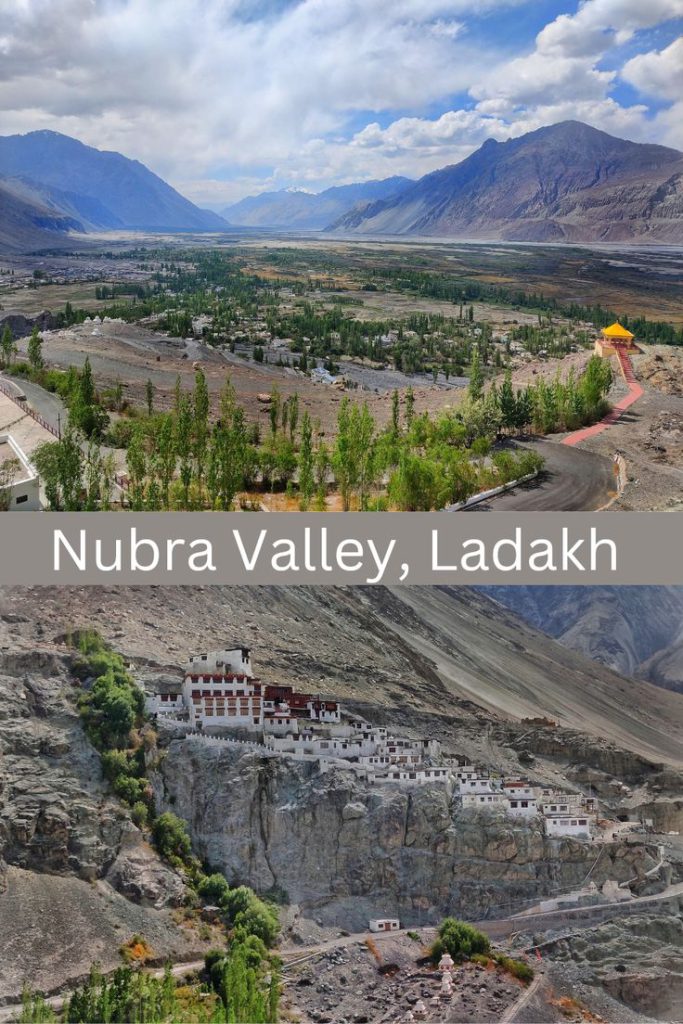
- Description: Often called the ‘Orchard of Ladakh’, Nubra lies north of Leh. This valley offers views of lush greenery contrasted with stark arid mountains, accessible via Khardung La, one of the highest motorable roads in the world.
- Activities: Bactrian camel rides through the sand dunes, visiting Buddhist monasteries like Diskit Monastery, and exploring the villages of Hunder and Turtuk.
Monasteries:
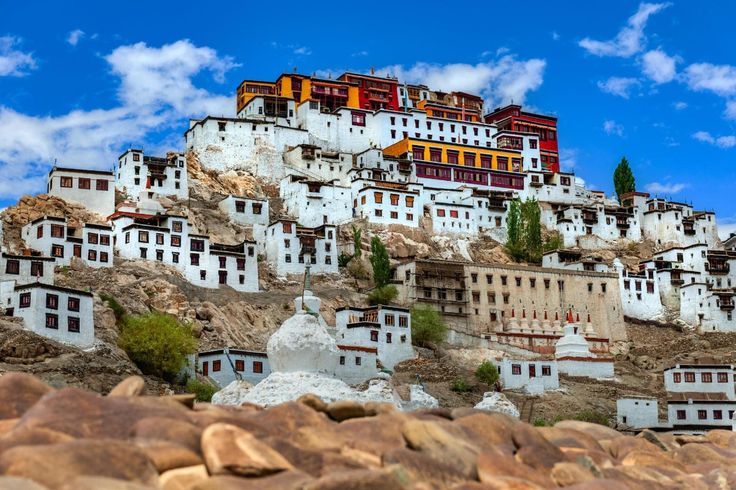
- Hemis Monastery: The largest and richest Buddhist monastery in Ladakh, Hemis is renowned for its annual Hemis festival that features colorful mask dances.
- Thiksey Monastery: Resembling the Potala Palace in Lhasa, this 12-story monastery houses many items of Buddhist art such as statues, swords, and thangkas.
- Lamayuru Monastery: Known as the Moonland of Ladakh, Lamayuru has a surreal appeal due to its moonlike landscapes.
Adventure Activities
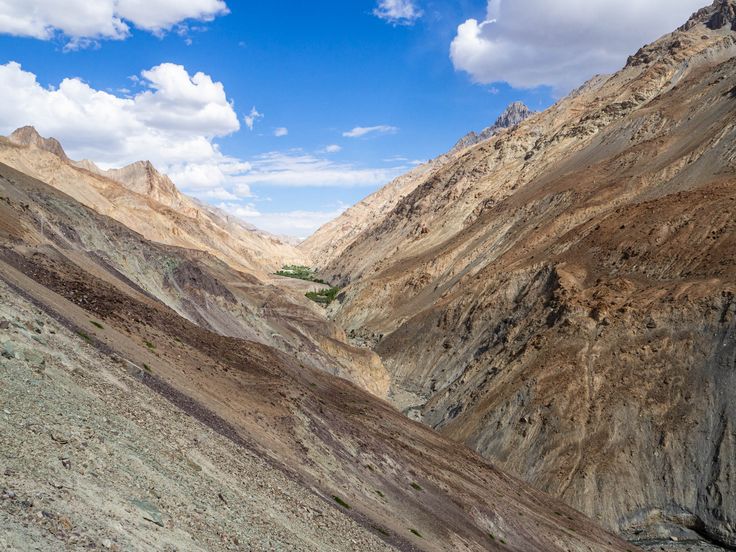
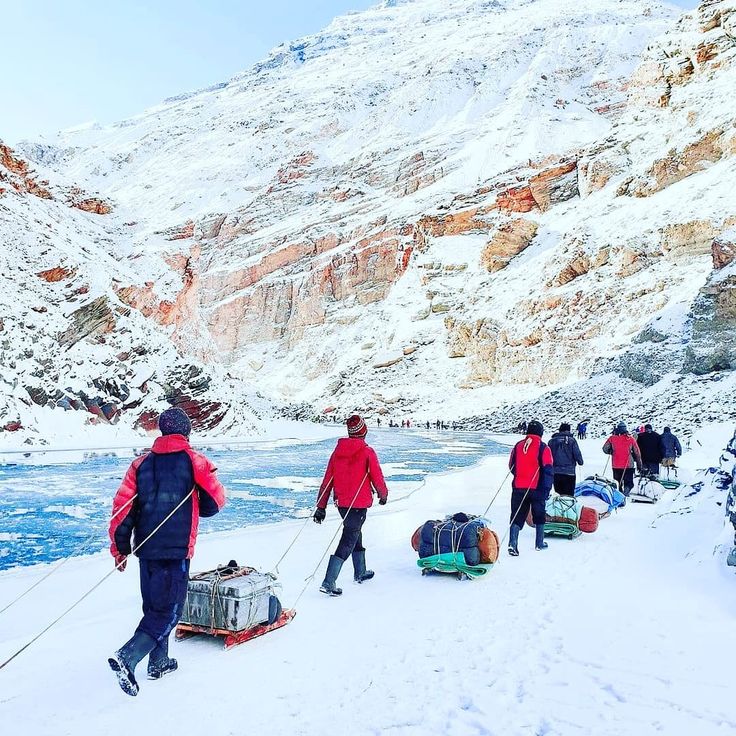
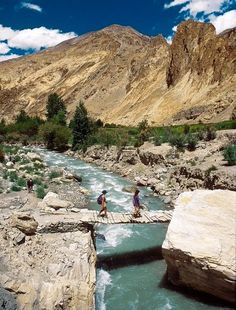
Trekking:
- Chadar Trek: A winter trek over the frozen Zanskar River, this is one of the most thrilling experiences in Ladakh, offering a mix of adventure and the stark beauty of icy landscapes.
- Markha Valley Trek: Popular for its diversity of landscapes, it passes through little hamlets, Buddhist monasteries, and high-altitude pastures.
- Stok Kangri Trek: One of the highest trekable summits in India, this is a challenging trek offering spectacular views from the top.
Mountain Biking:
- Khardung La Challenge: Biking up to the Khardung La pass offers an exhilarating experience for cycling enthusiasts looking for high altitude rides.
- Manali to Leh Cycling Expedition: This route covers some of the highest mountain passes in the world, surrounded by stunning landscapes.
River Rafting:
- Indus and Zanskar Rivers: These rivers offer exciting opportunities for white water rafting, ranging from Grade I to Grade V rapids, suitable for beginners as well as experienced rafters.
- Key Locations: Popular spots include the stretches between Phey to Nimo and from Upshi to Kharu, known for both their scenic beauty and thrilling rapids.
Local Cuisine
Leh-Ladakh offers a unique culinary experience with dishes that are not only a reflection of its cultural diversity but also adapted to its high-altitude climate. Here’s a guide to some must-try local foods and beverages, along with recommendations for places to eat.
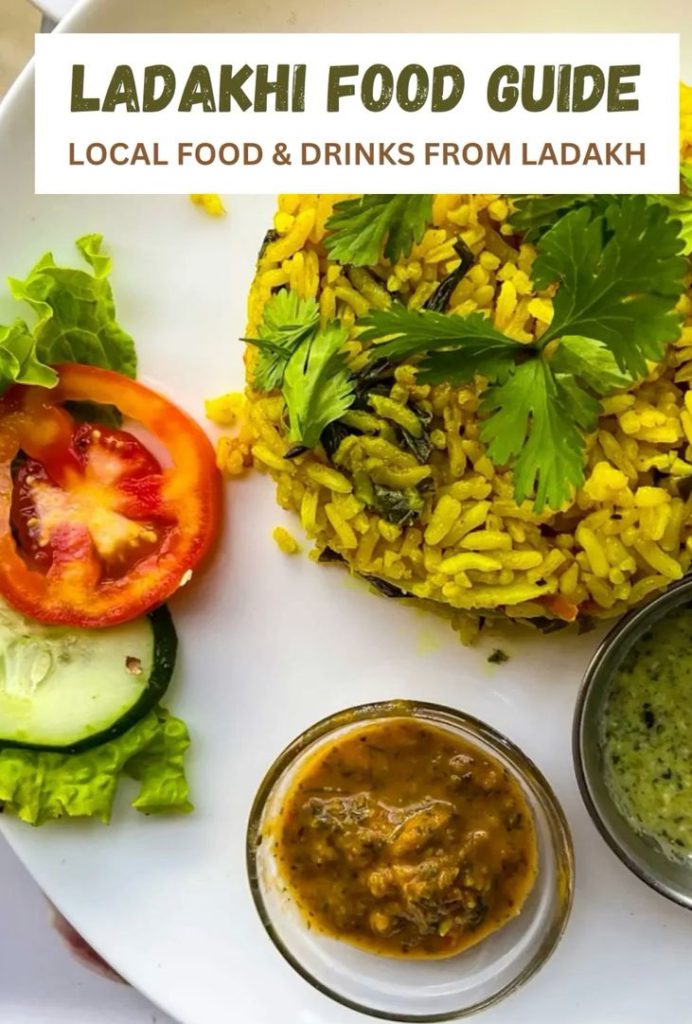
Highlights of Local Foods and Beverages
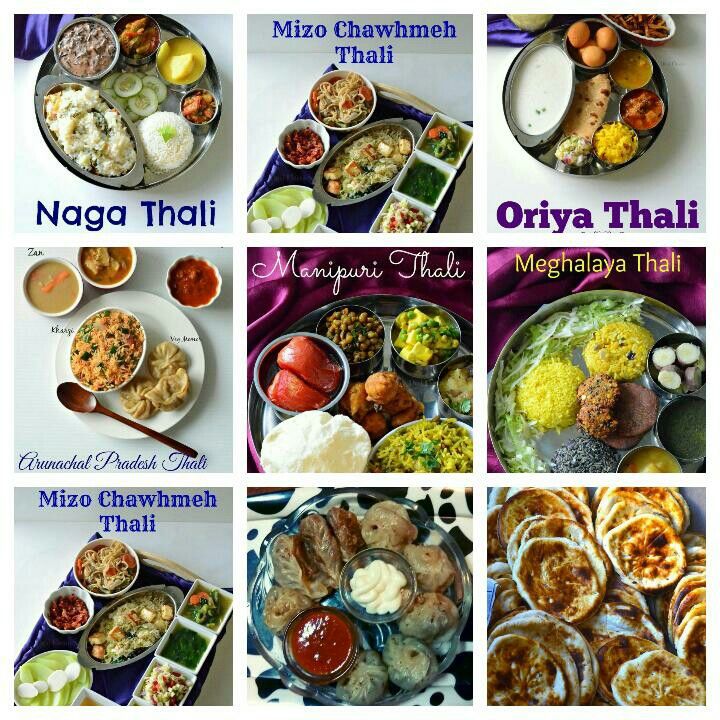
Thukpa
- A hearty noodle soup enriched with vegetables and meat, Thukpa is a Tibetan dish that has become a staple in Ladakhi cuisine. It’s perfect for the cold climate of Ladakh.
Momos
- Tibetan-style dumplings filled with either vegetables or meat, momos are a popular snack across Ladakh. They are usually steamed, though fried momos are also common.
Skyu
- A traditional Ladakhi dish, Skyu is made with hand-rolled, thumb-sized wheat flour dough cooked with root vegetables and meat. It’s particularly popular in the villages.
Tsampa
- Known as ‘roasted barley flour’, Tsampa is a versatile and essential part of Ladakhi diet. It is often mixed with butter tea to form a dough-like consistency that is both filling and nutritious.
Butter Tea
- A Ladakhi staple, this salty tea mixed with butter serves as a high-energy beverage ideal for the cold weather and high altitude.
Chang
- A locally brewed barley beer, Chang is a mild alcoholic beverage that is a part of local celebrations and daily life.
Recommendations for Restaurants and Eateries
Leh
- Gesmo Restaurant: Known for its freshly baked goods and a variety of dishes including good vegetarian options.
- Chopsticks Noodle Bar: Offers a mix of Ladakhi, Indian, and Pan-Asian cuisine, perfect for those looking to try different flavors.
Nubra Valley
- Tibetan Kitchen: Experience authentic Tibetan and Ladakhi food with a view of the surrounding mountains.
- Cafe Cloud: A great spot for a quick bite, especially if you’re craving some comfort food.
Pangong Tso
- Pangong Kitchen: Offers a variety of local dishes with the unbeatable view of Pangong Lake.
- Norling Cafe: A good spot for trying local beverages like butter tea and Chang.
Cultural Insights
- Insight into local festivals, customs, and traditions.
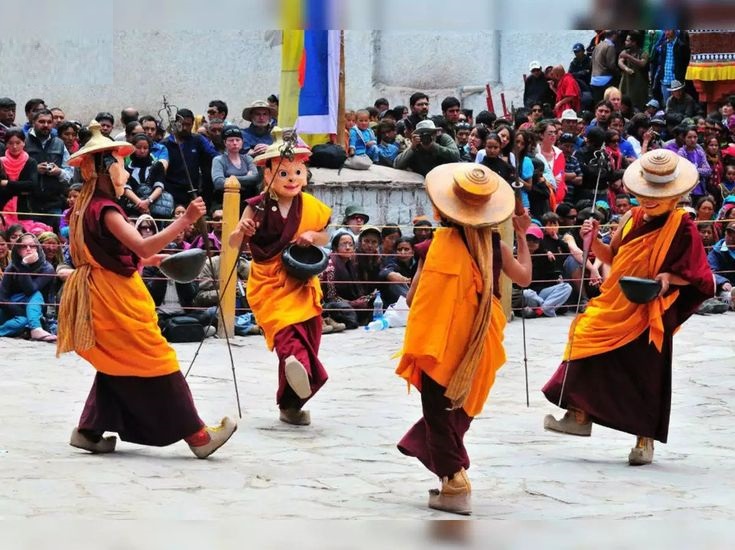
Local Festivals
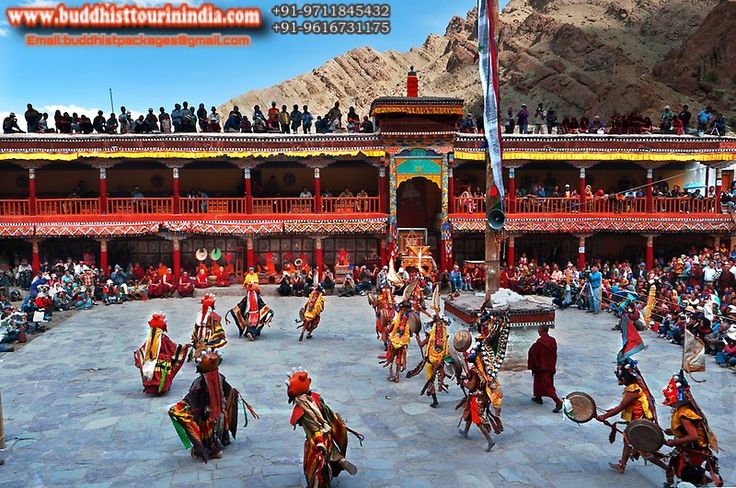
- Celebrated in June or July at the Hemis Monastery, this is the biggest and most famous festival in Ladakh. It commemorates the birth of Guru Padmasambhava, the founder of Tibetan Buddhism. The festival is marked by elaborate mask dances (Cham dances), vibrant costumes, and the display of ancient thangkas.
Losar Festival:
- The Tibetan New Year, called Losar, is celebrated with great enthusiasm in January or February. It includes ceremonies, dances, and the preparation of special foods. Homes and monasteries are adorned with decorations to welcome the new year.
Ladakh Festival:
- Held in September, this festival showcases the region’s culture, arts, crafts, sports, and folk dances. It provides a window into Ladakh’s heritage through music performances, archery competitions, and polo matches.
Customs and Traditions
Religious Practices:
- Buddhism is deeply ingrained in daily life, with frequent visits to monasteries, spinning prayer wheels, and the chanting of mantras being common practices among locals.
Clothing:
- Traditional Ladakhi clothing includes ‘gonchas’ (robe-like dresses) and ‘stove’ (Ladakhi hats). These are often worn during festivals and important occasions.
Hospitality:
- Ladakhis are known for their warmth and hospitality. It is common to be invited for tea or even a meal. Accepting such offers is a gesture of respect and appreciation for their culture.
Tips on Respectful Interaction
Language
- Learning a few basic phrases in Ladakhi or Tibetan can go a long way in showing respect and fostering goodwill.
Cultural Sensitivity
- When visiting monasteries, always dress modestly and follow local customs such as walking clockwise around religious structures and spinning prayer wheels in the direction they are set.
Photography
- Always ask for permission before taking photos of people, especially during religious ceremonies. Some areas in monasteries may prohibit photography entirely.
Environmental Respect
- Ladakh’s environment is fragile. Always adhere to eco-friendly practices such as disposing of waste properly and minimizing plastic usage.
Economic Support
- Engaging in community-based tourism, such as staying in homestays and buying local handicrafts, supports the local economy and contributes to sustainable tourism.
- Tips on respectful interaction with locals and participation in local customs.
Shopping and Souvenirs
Leh-Ladakh offers a unique shopping experience with its vibrant markets and distinctive local handicrafts. Exploring these markets not only provides a peek into the local lifestyle but also offers a chance to bring home a piece of this remarkable region.
Local Markets
Leh Main Market
- A bustling hub in the heart of Leh, this market features a variety of shops selling everything from handicrafts to Tibetan jewelry, and traditional Ladakhi clothing to organic products. It’s a great place to soak in the local atmosphere and find unique souvenirs.
Moti Market
- Near the Leh Bus Stand, Moti Market is known for its assortment of semi-precious stones and pearls. It’s an ideal spot for those looking to buy local jewelry.
Tibetan Refugee Market
- A special market run by Tibetan refugees, this is the place to find Tibetan handicrafts, handmade carpets, woolen clothes, and traditional Tibetan jewelry.
Unique Items to Buy
Pashmina Shawls
- Authentic Pashmina, made from the fine wool of Changthangi goats, is a luxurious souvenir. These shawls are known for their softness and warmth.
Tibetan Handicrafts
- Includes prayer wheels, Buddha statues, and Thangka paintings, which are colorful and detailed artworks used in Buddhist rituals.
Ladakhi Jewelry
- Traditional Ladakhi jewelry made from turquoise and coral is not only beautiful but also holds cultural significance.
Apricot Products
- Ladakh is famous for its apricots. Local products such as apricot oil, jam, and dried apricots are popular among health-conscious buyers.
Shopping and Souvenirs in Leh-Ladakh
Leh-Ladakh offers a unique shopping experience with its vibrant markets and distinctive local handicrafts. Exploring these markets not only provides a peek into the local lifestyle but also offers a chance to bring home a piece of this remarkable region.
Local Markets
Leh Main Market
- A bustling hub in the heart of Leh, this market features a variety of shops selling everything from handicrafts to Tibetan jewelry, and traditional Ladakhi clothing to organic products. It’s a great place to soak in the local atmosphere and find unique souvenirs.
Moti Market
- Near the Leh Bus Stand, Moti Market is known for its assortment of semi-precious stones and pearls. It’s an ideal spot for those looking to buy local jewelry.
Tibetan Refugee Market
- A special market run by Tibetan refugees, this is the place to find Tibetan handicrafts, handmade carpets, woolen clothes, and traditional Tibetan jewelry.
Unique Items to Buy
Pashmina Shawls
- Authentic Pashmina, made from the fine wool of Changthangi goats, is a luxurious souvenir. These shawls are known for their softness and warmth.
Tibetan Handicrafts
- Includes prayer wheels, Buddha statues, and Thangka paintings, which are colorful and detailed artworks used in Buddhist rituals.
Ladakhi Jewelry
- Traditional Ladakhi jewelry made from turquoise and coral is not only beautiful but also holds cultural significance.
Apricot Products
- Ladakh is famous for its apricots. Local products such as apricot oil, jam, and dried apricots are popular among health-conscious buyers.
Tips on Bargaining and Shopping Etiquette
Bargaining
- Bargaining is common in the local markets of Leh-Ladakh. It is usually expected that you will negotiate the price, especially in tourist-heavy areas. A good rule of thumb is to start at about half the offered price and negotiate up to a middle ground.
Be Respectful
- While bargaining, always maintain a polite and friendly demeanor. Respectful negotiation is appreciated and can often lead to better prices.
Cash Transactions
- Most transactions in the markets are done in cash. While some shops might accept credit cards, carrying cash is advisable for smoother transactions.
Support Local Artisans
- Whenever possible, buy directly from artisans or cooperatives. This ensures that your money goes directly to the craftspeople and supports the local economy.
Travel Itineraries
- Suggested itineraries for different durations (e.g., 3 days, 1 week, 2 weeks).
Itineraries by Duration
| Duration | Itinerary |
|---|---|
| 3 Days | Day 1: Acclimatize in Leh, explore local markets and Leh Palace Day 2: Visit Thiksey Monastery, Hemis Monastery, and Shey Palace. Day 3: Sunrise at Shanti Stupa, visit the confluence of the Indus and Zanskar Rivers, Magnetic Hill. |
| 1 Week | Days 1-3: Follow the 3-day itinerary. Day 4: Travel to Nubra Valley via Khardung La, stay in Hunder/Diskit. Day 5: Diskit Monastery, camel safari in Hunder. Day 6: Return to Leh, rest day. Day 7: Day trip to Pangong Lake. |
| 2 Weeks | Days 1-7: Follow the 1-week itinerary. Day 8: Travel to Tso Moriri, stay in Korzok. Day 9: Explore around Tso Moriri, visit Korzok Monastery. Day 10: Travel to Sarchu via Tsokar Lake, stay in Sarchu. Day 11: Continue to Manali via Baralacha La, stay in Manali. Days 12-13: Explore Manali. Day 14: Buffer/rest day in Leh. |
Themed Itineraries
| Theme | Itinerary |
|---|---|
| Adventure | Days 1-3: Acclimatize and explore Leh. Day 4: River rafting on Zanskar River. Days 5-7: Trek Markha Valley or Stok Kangri. Days 8-9: Mountain biking to Khardung La. Day 10: Rest in Leh. |
| Cultural Immersion | Days 1-2: Explore monasteries and museums in Leh, cooking class. Days 3-4: Travel to Nubra, village homestay. Days 5-6: Visit Alchi and Likir, interact with artisans. Day 7: Cultural show or local music performance in Leh. |
| Relaxation | Days 1-2: Gentle exploration of Leh, Shanti Stupa, local cafes. Days 3-4: Spa and wellness treatments or yoga retreat in Leh. Days 5-6: Relax at Pangong Lake. Day 7: Leisure day in Leh, light shopping. |
Health and Safety
Tips on staying healthy in high altitudes.
Acclimatization
- Spend the first 48 hours after arrival avoiding strenuous activity to allow your body to adjust to the high altitude. This helps prevent altitude sickness.
Hydration
- Drink plenty of water to stay hydrated. The dry, cold climate can lead to rapid body water loss, which can exacerbate altitude sickness.
Diet
- Eat light, high-carbohydrate meals to maintain energy levels and facilitate easier digestion, which can be slower at high altitudes.
Sun Protection
- At high altitudes, UV radiation is stronger. Always wear sunscreen, lip balm with SPF, and sunglasses to protect against sunburn and eye damage.
Layered Clothing
- The weather can change rapidly. Wear multiple layers that you can add or remove as necessary to manage body temperature effectively.
Avoid Alcohol and Smoking
- Both can dehydrate you and increase the risk of altitude sickness.
Information on necessary vaccinations and medical facilities.
Necessary Vaccinations
Routine Vaccinations
- Ensure that routine vaccines such as measles, mumps, rubella (MMR), diphtheria-tetanus-pertussis, varicella (chickenpox), polio, and your yearly flu shot are up to date.
Hepatitis A
- Recommended for most travelers, including those staying with friends or relatives or visiting smaller cities or rural areas.
Typhoid
- Especially recommended for travelers visiting smaller cities or rural areas, or if you are an adventurous eater.
It’s best to consult with a travel medicine specialist at least 4-6 weeks before your trip to discuss these vaccinations and any others that might be recommended based on your health history.
Medical Facilities
Leh
- The main town of Leh has several medical facilities, including the Sonam Norboo Memorial Hospital, which is equipped to deal with general medical problems and emergencies. However, facilities for severe medical conditions may be limited.
Pharmacies
- Pharmacies in Leh are well-stocked with basic medications, but it’s advisable to bring specific medications from home, especially if you require prescription drugs.
Evacuation Insurance
- Consider obtaining travel health insurance with high-altitude evacuation coverage. Access to some areas in Ladakh can be challenging, and having evacuation options is prudent.
Information on necessary vaccinations and medical facilities.
Photography and Etiquette
Photography in Leh-Ladakh offers the chance to capture some of the most stunning landscapes and vibrant cultural scenes in the world. However, respecting local customs and regulations is crucial to ensure a positive experience for both photographers and the community. Here are some essential guidelines and information about restricted areas for photography.
Guidelines on photography dos and don’ts.
Dos:
- Ask for Permission: Always seek permission before taking photos of local people, especially during religious ceremonies or in monasteries. This is respectful and often leads to more meaningful interactions.
- Use Respectful Distances: When photographing sensitive locations like religious sites or cultural ceremonies, maintain a respectful distance to avoid disrupting the activities.
- Be Aware of Your Surroundings: Be conscious of where you are stepping or what you are standing in front of when taking photos. Avoid blocking others’ views or access, especially in crowded places.
- Respect Signs and Rules: Adhere to all signage regarding photography, which might restrict camera use in specific areas.
Don’ts:
- Don’t Photograph at Restricted Sites: Some areas, particularly military installations, bridges, and some religious sites, explicitly prohibit photography. Always observe and respect these rules.
- Don’t Use Flash in Monasteries: Flash photography can damage ancient murals and artifacts found in many of Ladakh’s monasteries. It’s also disruptive to the atmosphere of these serene places.
- Don’t Interrupt Ceremonies: During festivals or religious ceremonies, be mindful not to interrupt proceedings with your photography. The event is not a tourist spectacle but a significant aspect of local culture.
Areas where photography might be restricted.
Military Areas:
- Many areas in Ladakh are sensitive due to their proximity to international borders. Photography near military installations or equipment is strictly prohibited and can lead to legal action.
Religious Sites:
- Some monasteries and religious sites may have restrictions on where you can photograph or might ban it altogether inside specific chambers. These restrictions are often in place to protect the sanctity of the site and its artifacts.
Government Buildings:
- Like in many other regions, photographing government buildings and airports is generally restricted.
To ensure a fulfilling photography experience in Leh-Ladakh, always carry your camera responsibly, be aware of and comply with local customs and restrictions, and use photography to share and celebrate the beauty of Ladakh respectfully. This approach not only enhances your travel experience but also helps maintain the dignity and privacy of the local people.
Practical Tips
Understanding the local infrastructure in Leh-Ladakh, especially regarding currency, banking services, and connectivity, is essential for a smooth and hassle-free journey. Here’s a detailed guide to help you manage these aspects effectively during your trip.
Information on local currency, banking services, and ATMs.
Currency
- The local currency in India, including Leh-Ladakh, is the Indian Rupee (INR). Notes come in denominations of 10, 20, 50, 100, 200, 500, and 2000 rupees.
Banking Services
- Banks: Leh has branches of several major Indian banks such as the State Bank of India, Punjab National Bank, and Jammu & Kashmir Bank. These banks provide comprehensive services, including currency exchange.
- ATMs: ATMs are widely available in Leh town, but their presence is sparse in remote areas like Nubra Valley and Pangong Tso. Ensure you carry sufficient cash when traveling outside of Leh, as ATM connectivity can be unreliable.
Tips for Money Management
- Carry Cash: In remote areas, cash is essential as digital transactions may not always be possible.
- Inform Your Bank: Before traveling, inform your home bank of your travel plans to avoid any blocks on your cards when used in a new location.
Connectivity: Mobile Services and Internet Availability
Mobile Services
- Network Coverage: The main mobile networks operating in Leh include BSNL, Airtel, and Jio. Of these, BSNL has the widest coverage, but Airtel and Jio offer faster data services in areas where they are available.
- SIM Cards: Tourists can purchase local SIM cards; however, due to security regulations in Jammu and Kashmir, this might require additional identity verification and local references.
Internet Availability
- Internet Cafes: In Leh town, several internet cafes offer basic internet services. Speeds might be slower than what you’re accustomed to.
- Hotel Wi-Fi: Many hotels in Leh offer Wi-Fi, though the service can be intermittent and is often not available in more remote locations or during power outages.
- Dongles: For more consistent internet access, consider renting or purchasing a USB internet dongle from one of the local telecom providers.
Tips for Staying Connected
- Prepare for Limited Access: In many parts of Ladakh, especially in remote regions, connectivity can be minimal. Prepare to be offline at times.
- Download Maps and Information: Before heading into more isolated areas, download offline maps and any necessary information as a backup.
- Portable Power Banks: Carrying a portable power bank is advisable to keep your devices charged, especially when exploring areas with limited electricity access.
Emergency Information
When traveling to remote and rugged regions like Leh-Ladakh, it’s essential to be prepared for any emergencies. Here’s crucial information including contact details for emergency services and practical tips on handling emergencies.
Emergency Contacts
Hospitals
- Sonam Norboo Memorial Hospital: The main hospital in Leh, equipped to handle various medical emergencies.
- Contact: +91-1982-253626
- SNM Hospital: Another important hospital in Leh providing emergency services.
- Contact: +91-1982-252014
Police Stations
- Leh Police Station: Handles law and order in Leh town.
- Contact: +91-1982-252018
- Tourist Police: Specifically assists tourists with any law-related issues.
- Contact: +91-1982-252283
Consulates
- Depending on your nationality, the location of the nearest consulate will vary. The closest major cities with consular services are New Delhi and Chandigarh. In an emergency, contacting your country’s embassy in New Delhi is advisable.
Fire Service
- Leh Fire Service: In case of a fire emergency in Leh.
- Contact: 101 or +91-1982-252222
Tips on What to Do in Case of an Emergency
Medical Emergencies
- Seek immediate help at the nearest hospital. For serious conditions, medical evacuation to a better-equipped facility in Delhi or Chandigarh might be necessary.
- Always carry a list of emergency contacts and your medical history/allergy information easily accessible.
Law and Order
- Contact the nearest police station if you face any legal trouble or notice suspicious activity. Tourist police are specifically helpful for issues affecting travelers.
- Keep a photocopy of your passport, visa, and other important documents separately from the originals.
Accidents
- In case of a vehicle accident, contact local authorities immediately. Avoid moving the injured unless absolutely necessary to prevent further injuries.
- Report the accident to your rental agency and insurance provider as soon as possible.
Natural Disasters
- Leh-Ladakh is prone to sudden weather changes and natural disasters like landslides. Always heed local advice and warnings.
- In case of being caught in a natural disaster, follow the instructions of local emergency services. Have an emergency kit ready with essentials like water, snacks, basic first aid, and warm clothing.
Lost or Stolen Items
- Report any lost or stolen items to the local police station and your consulate if necessary. Keep digital copies of important documents in your email or cloud storage for easy access.

Awesome travel guide!!.It is very useful specially for first time travellers